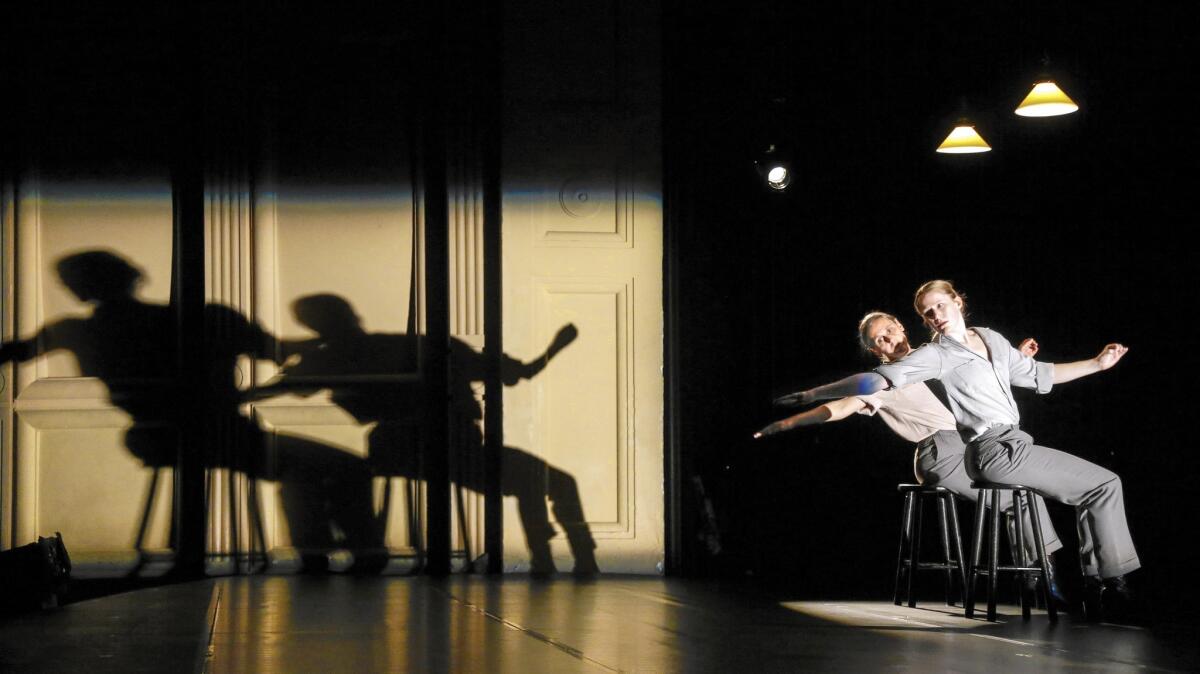Dance review: ‘Fase’ a mesmerizing Minimalism map to Steve Reich’s music

- Share via
In “Fase, Four Movements to the Music of Steve Reich,” which Flemish choreographer Anne Teresa De Keersmaeker brought to Royce Hall on Tuesday night, one plus one equals two, allowing for an almost imperceptible margin of error. The amount of error is exactly right. You know it is there but don’t really see it. It is the soul of the machine.
This 1982 work is what put De Keersmaeker on the dance map — and the Minimalism map. She and a partner mimic four rigorously patterned early pieces by Reich. At Royce, De Keersmaeker and Tale Dolven precisely followed with their feet and arms Reich’s obsessively repeated rhythmic figures as they mechanically go in and out of phase.
SIGN UP for the free Essential Arts & Culture newsletter >>
The dancers’ synchronization, memory feat and endurance can seem superhuman. But that is not what makes them mesmerizing to watch and makes music that can easily get on your nerves feel full of life. The two women are severe and humorless, yet they exude joy as they remain on Reich’s treadmill to the degree it is humanly possible.
They can’t overcome the limits of physiology. It takes a dancer’s foot a fraction of a second longer to touch the ground than it does pianist’s finger to hit a keyboard in “Piano Phase.” “Come Out” is an electronic score that was created by cutting and splicing recording tape; no dancer can physically match the fine scale of a ruler.
De Keersmaeker and Dolven come so impressively close that everything looks right, but it is their fractions of a second or fractions of a millimeter variances that convey the quality of deeply touching humanity. They show patterns to be as much the provenance of nature as mathematics.
It has been 30 years since De Keersmaeker’s only other Los Angeles appearance. So the Center for the Art of Performance at UCLA is now attempting to make up for lost decades with a four-night retrospective of De Keersmaeker’s work with her company Rosas at Royce, which will conclude with two recent pieces — last year’s “Verklärte Nacht (set to Schoenberg’s “Transfigured Night”) on Friday and the 2-year-old “Vortex Temporum” Saturday.
The latter is set to Gérard Grisey’s hour-long ensemble work that in 1996 epitomized Spectral music, a French reaction to American Minimalism in which computer-assisted computations are used to create a complexly captivating new sonic language.
De Keersmaeker is the rare, sophisticated choreographer who can not only handle both of these competing styles, but who can show their rarely acknowledged commonality. One style finds a mathematical use for rhythmic, the other for harmony. Still, dancers thrive on rhythm, and De Keersmaeker’s most enduring music partnership has been with Reich.
The distinguishing feature of Reich’s early phase pieces — which at Royce were heard on recordings turned up gratingly loud (the way the composer likes it) — is that when rhythmic patterns played by pairs of instruments or tapes of a single speaking voice start to get off the beat, one instrument from the other, funny things happen with overtones. There is a fracturing effect that makes it seem as if the patterns are reproducing and the ear starts to hear new sounds.
This, De Keersmaeker captures brilliantly in “Piano Phase” through the play of the dancers’ shadows on a rear screen. “Come Out” is more disturbing. Reich’s tape fractures a sentence spoken by a young man accused of helping incite the Harlem riot of 1964. De Keersmaeker and Dolven sat in seats under overhead lights, as though being interrogated. Their arms and heads were in motion not to the music but as though giving testimony of the music, which is a powerful effect.
“Violin Phase” is the one solo, and here De Keersmaeker weaves wonderful circular designs. The brief “Clapping Music,” Reich’s well-known party piece for two percussionists clapping their hands in phase-altering rhythms, provides a sweet coda for the two dancers in silent movie antic mode.
This shows the influence of Lucinda Childs’ work in “Einstein on the Beach,” but it also served as a kind of waving goodbye and moving on. The other founding fathers of Minimalism had already had choreographers who helped make their music accessible — Anna Halpern for Terry Riley, Childs for Philip Glass.
With “Fase,” De Keersmaeker gave a new look to Minimalism.
It still looks amazing.
Follow me on Twitter @markswed
------------
Anne Teresa de Keersmaeker
Where: Royce Hall, UCLA
When: 8 p.m. Thursday (“Rosas Danst Rosas”), Friday (“Verklárte Nacht”) and Saturday (“Vortex Temporum” with Ictus).
Cost: $19-$69
Info: (310)-825-2101, www.cap.ucla.edu.
More to Read
The biggest entertainment stories
Get our big stories about Hollywood, film, television, music, arts, culture and more right in your inbox as soon as they publish.
You may occasionally receive promotional content from the Los Angeles Times.











